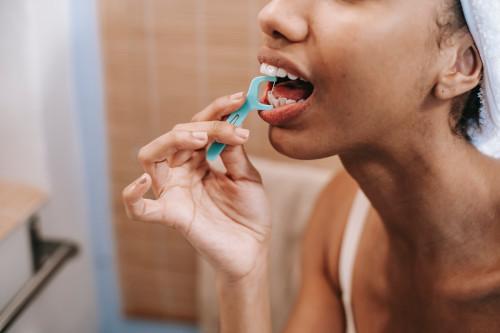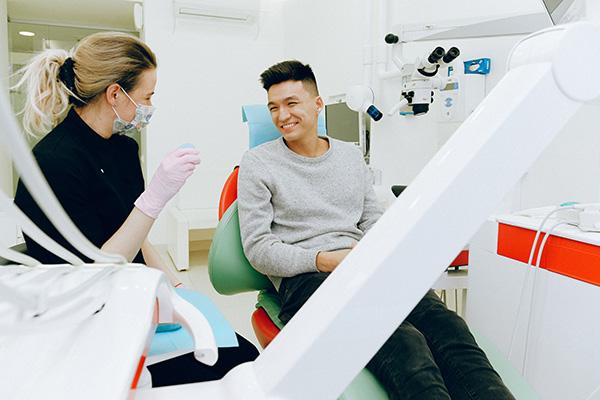Achieving a Lasting Healthy Smile
A healthy smile is easily attainable with proper home care and the help of a team of dental professionals. The combination of good hygiene habits, supporting dental products, and regular dental checkups will set you up for a successful healthy smile.
Table of Contents
Your Oral Hygiene Routine
Brushing

A healthy smile depends on the mechanical removal of food, plaque, and bacteria daily. The American Dental Association recommends you brush 2 times a day for 2 minutes. Incorporate the following when establishing a brushing routine.
- Always choose a soft-bristled toothbrush. Change your toothbrush every 3-4 months to ensure the bristles remain in the best shape.
- Hold the toothbrush bristles at a 45-degree angle toward the gum line. Use short back and forth strokes on the outside, inside, and chewing surface of the teeth.
- An electric toothbrush is more efficient than a manual toothbrush. It will also protect the gums by preventing recession. Check out our article Electric Toothbrush Benefits to learn more.
Flossing

Brushing only cleans two-thirds of the tooth surface. Flossing supports a healthy smile by removing food that you may not even feel trapped. No matter how hard or long you brush, the bristles cannot mechanically clean in between the teeth. An effective flossing routine includes:
- The best time to floss is before bed when your body is resting and not fighting the bacteria.
- Thicker floss is better and will remove more. To get the most out of flossing, stay away from thin ribbon floss.
- Wrap the floss around your middle finger, leaving a few inches in between for your pointer finger and thumb to pinch and guide. Curve the floss into a C-shape and move up/down against one side, then the other, before taking it out and moving onto the next.
Flossing for a healthy smile is all about creating the habit. Start out small and strive for 4 days a week, slowly adding on. Try using a floss pick, then graduate to string floss. For more help, check out our Floss Dental Care Tips article.
Home Care Products
Dental products are great resources to support your toothbrush and floss. Choose a product that supports your needs to attain a healthy smile. This may include anti-gingivitis, dry-mouth, whitening, or sensitivity items.
- Toothpaste: Selecting a specific toothpaste that fits your needs is an easy way to improve your oral health. Choose a fluoridated, non-abrasive toothpaste to protect tooth enamel.
- Mouthwash: This can be a supportive product to add to your daily routine. It is important to think of mouthwash as an additive. Oral rinses do not mechanically remove the plaque and bacteria like the combination of a toothbrush and floss.
- Water: A steady water intake throughout the day will neutralize bacteria and help clean out food debris. Most bottled water brands are an acidic pH that aids in enamel breakdown.
Additional Tools for a Healthy Smile
- Water Flossing: The pressurized stream of water mechanically removes food, plaque, and bacteria. Place the tip near the gums, follow the curve of the gumline, and pause in between the teeth before moving on.
- Proxy brushes: Interdental brushes will remove food particles and plaque from between the teeth. They do not work well for wiping the sides of the teeth so flossing is still recommended.
- Nutrition: Diet plays a huge role in your healthy smile. Sugar increases your risk for cavities and acids can lead to erosion and weakened enamel. Alcohol and caffeine beverages will dry out the mouth. All these factors increase the activity of harmful bacteria leading to poor oral hygiene. For a more detailed nutritional guide, check out Dental Nutrition Guide.
The Mouth is the Gateway to the Body
The whole body is connected which makes it even more important to find stability in your oral health. Prioritizing a healthy mouth can impact several systemic diseases and help attain stability improving overall health.
- Diabetes: Gum disease (periodontal disease) makes it harder for patients to control blood sugar. Improper wound healing increases the risk of infections including gingivitis. Learn more with our article Diabetes and Oral Health.
- Heart Disease: Inflammation and infections from bacteria in the mouth have access to the bloodstream and throughout the body.
- Cancer: Aggressive bacteria in the mouth can enter the bloodstream and aid in abnormal cell growth.
- Rheumatoid Arthritis: Bacteria causes inflammation in the mouth that can trigger an inflammatory response in the body exacerbating the disease.
Frequently Asked Questions
What is a healthy smile?
A healthy smile is measured by the health of your teeth and gums. It is never too late to achieve a healthy smile with good home care habits and routine cleanings and exams by your dental home. Bacteria is always present in the mouth. It is important to manage this bacteria through brushing, flossing, and dental nutrition.
Why is a healthy smile important?
Good oral hygiene is important for your mouth and the whole body. Poor oral hygiene will affect the teeth interfering with nutrition. Gum disease is also associated with several systemic diseases and can exacerbate the disease progression.
Take Home Smile Store
Visit our Take Home Smile store for educational brochures and other fun printables to help with oral hygiene. All products can be customized to fit your dental needs.



